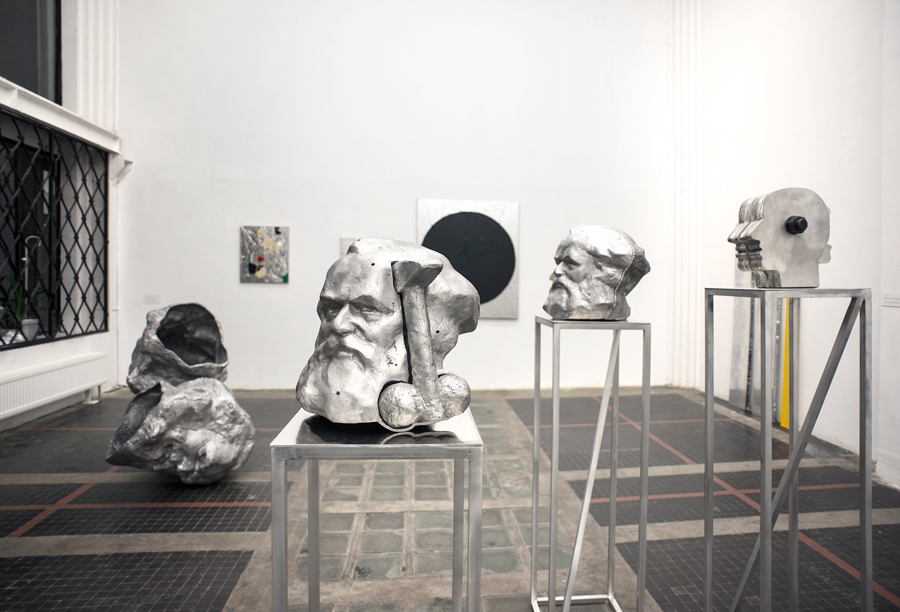Karl Marx makes a fine jack-o’-lantern. Perched on a street-facing windowsill and glowing an eerie green, Marks Trepanowany (Marx Trepanated, 1978–2013) is one of the many sculptures by Krzysztof M. Bednarski on view in the seven-artist Aluminum Song. Underpinned by the familiar European narrative of a now waning, but not so long ago booming postwar industry, the exhibition takes aluminium as its guide, a metal spurring associations with the everyday (furniture and cars) and the fantastic (spaceflight).
Grouped in Raster’s front gallery are Bednarski’s mocking, jocular aluminium assemblages of Marx portraits. Two floor-bound sculptures consist of conjoined heads, while elsewhere Marx’s bust has a phallic-shaped hammer – a testosterone-pumped half of the communist symbol – nestled into its side. Bednarski’s satirical proliferations of the portrait have hollowed out its political meaning: what once flew in the face of socialist imagery today verges on kitsch. Hung nearby are Marian Bogusz’s compositions painted directly onto thin polished aluminium plates, which, too, betray a passage of time. Though still reflecting light, these once lustrous mid-1970s abstract paintings have faded, the modernity promised by the new material now dulled. A similar fate might await the new works by Przemek Matecki and Piotr Łakomy, which also employ ready-to-hand aluminium-based technology likely to warp. In Matecki’s paintings (all Untitled, 2014), canvases are roughly wrapped with aluminium foil and covered with acrylic splodges or regular geometrical forms – lines or a circle. As in Bogusz’s works, the shiny aluminium surfaces are both backgrounds and inherent to the composition, shimmering with light and reflecting the surrounding space. Leaning against a wall, Łakomy’s Untitled (2014) is a triptych of roughly cut, hightech industrial aluminium-based honeycomb wedges. Unlike Matecki’s kitchen-standard foil, Łakomy uses new lightweight composite panels at the height of current aluminium technology.
Most poignant in Aluminum Song is the contrast between the photographs by Paweł Pierściński and Jan Smaga. Selected from a 1967–8 series shot by Pierściński in the Polish Świętokrzyski region, the black-and-white photographs show proto-sculptural forms – coils and tubes – fabricated in foundries by anonymous workmen. Smaga’s MSNKDT (2010), a concertina-shaped album displayed unfolded on a table, documents the abandoned skeletal interior of a prefabricated market hall, its floor strewn with rubbish. It is the site where the new building that will house Warsaw’s Museum of Modern Art is to stand, its realisation a quest so far fraught with difficulty, as the city’s municipality withdrew its contract with architect Christian Kerez in 2012. While Pierściński’s photographs celebrate a once thriving industry (which today primarily continues outside of Europe), Smaga’s album considers a wrecked in-between space, a site awaiting its uncertain future.
This article was first published in the March 2015 issue.
